Despite all the trouble that weeds bring to your lawn, some of them can be quite beautiful. Now, by no means is that an endorsement of the notion that you should just allow them to bloom and take over your lawn. Instead, let’s turn the beautiful flowers that some weeds produce into a means of identifying and attacking them before they get too far along.
That’s what this article is all about. We’re going to look at common weeds with white, yellow, pink, purple, and blue flowers. You’ll not only have a visual representation of each weed to guide you, but included in each weed identification will be the physical description of each of these pesky invaders. You’ll also learn about the problems they can cause in your lawn along with how you can control and eliminate them from your yard.
Some weeds grow taller than others, but it doesn’t make them any less bothersome. So, besides the weeds you find growing nearer the surface of your lawn, we’ll also detail lawn and garden weeds that grow a bit taller before their flowers bloom.
So check out this comprehensive article before these troublesome, although beautiful, common weeds show up on your lawn and become too difficult to control.
After you identify the invasive plants in your lawn, you’ll want to make sure you are taking care of your grass properly for a beautiful lawn. If you have Bermuda grass, make sure to check our guide on how to maintain a beautiful Bermuda grass lawn.
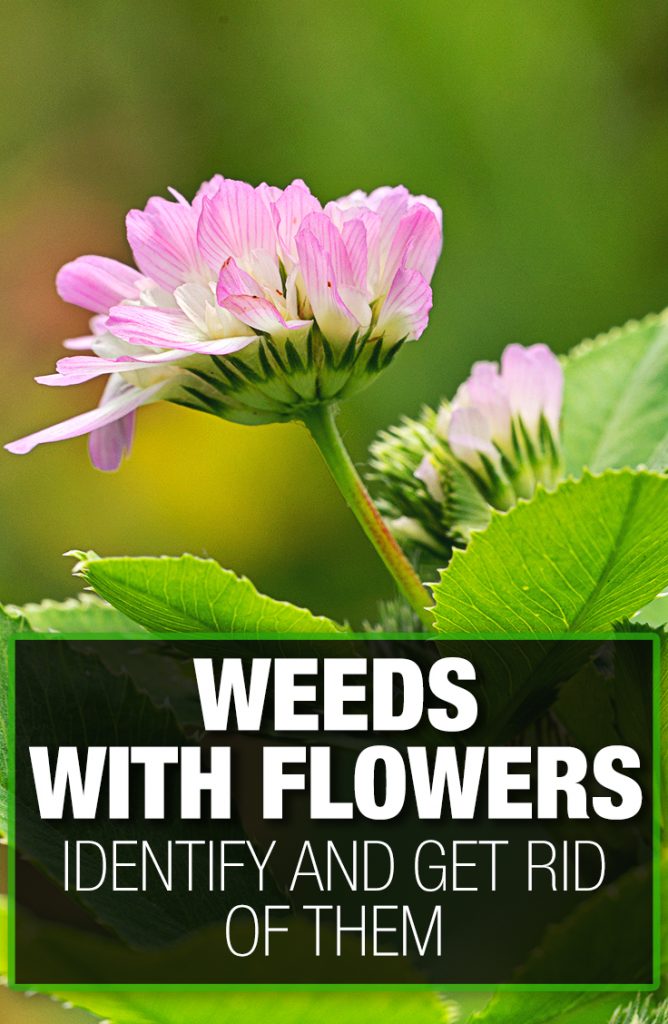
Weeds With White Flowers
White Clover
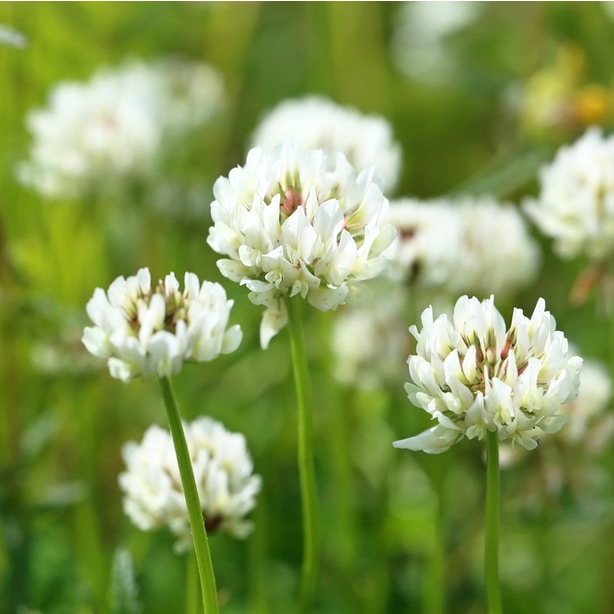
Weed Identification
White clover is one of the most common lawn weeds. This broadleaf perennial weed has compound leaves with 3 broad leaflets that you’re probably very familiar with. Each leaf has tiny teeth running along its edges and a very pale triangular mark across its surface. Each leaf is rounded and can grow to breadths of from ¼ to 1 inch.
The long, pea-like small white flower appears from May to September and can also be very pale pink in color. Each flower grows on separate stalks from the leaves, with 40 to 100 individual florets making up each of the flower heads.
Problems Caused
White clover is a common lawn weed that grows prodigiously and very aggressively. Coupled with the fact that the weed employs nitrogen fixation, it is very opportunistic and grows on soils with poor fertility. Having a smaller amount of these common weeds in your lawn isn’t necessarily bad because it is a natural fertilizer. In fact, if 5% of your lawn is made up of clover, the entire lawn receives an adequate supply of nitrogen.
That being said, clover growth is very difficult to control. And any problems you have on your lawn will make it that much easier for clover to outgrow your desired turfgrass. Because of its growth rate and the likelihood that it will overtake your desired grass, it’s recommended that you rid your lawn of this common broadleaf weed.
Weed Control Methods
You can control the growth of this common lawn weed on your property by pulling it from the ground. This is generally recommended for smaller areas of white clover.
Natural control methods include mulching over the area and mowing your grass at a higher level. There are both natural and chemical applications for clover growth.
The best way to control white clover is through proper lawn care practices and preventative maintenance.
Common Chickweed

Weed Identification
Common chickweed is a low-growing winter annual weed that germinates in cool, wet weather. Its smooth leaves are elliptical in shape and grow opposite each other. The chickweed grows in a dense mat across the ground that branches out frequently near the base. Branching occurs less frequently the further out you travel from the base of the plant. The leaves are somewhat hairy on the bottom surface and hairless on the top.
The white flowers of this winter annual are small and comprise 5 petals that, at first glance, appear to be 10. The bifid petals surround a light green ovary. The flowers are single or in leafy clusters at the end of branching stems and are about ¼ of an inch wide.
Problems Caused
Controlling the growth of this annual weed is extremely difficult. Its aggressive growth can smother the desired vegetation in your lawn or garden.
Of greater concern is that the common chickweed is a reservoir for insect pests and plant viruses.
Weed Control Methods
Whenever possible, you should rely on natural control methods like hand weeding, cultivation, mulching, and solarization to combat this weed. If you’re able to catch common chickweed early, these manual methods should be able to rid your lawn of it.
As always, ensuring the health of your lawn and its vigor by using proper lawn care practices and preventative maintenance is the best way to combat chickweed. It will ensure that it doesn’t have room to grow in the first place.
However, if you feel that a chemical alternative is your best option, then several quality pre and post-emergent products are commercially available to purchase. It’s advised that you use a pre-emergent product and prevent this weed from showing up on your lawn. Because once it spreads, it becomes challenging to contain.
Mouse Ear Chickweed
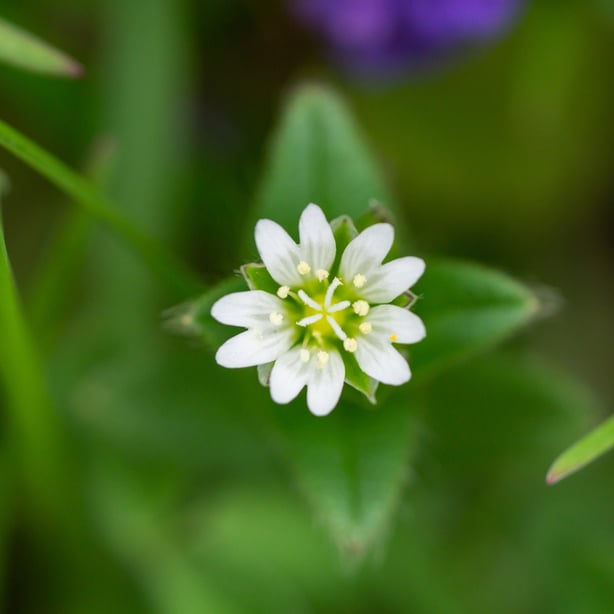
Weed Identification
Mouse-ear chickweed closely resembles common chickweed because it grows in dense, low growing mats, but its growth is not as aggressive. The grey-green leaves of this perennial weed are thick and covered in fine hairs.
Flowers bloom from early spring through the late fall months. The flowers have 5 white petals and can be found in clusters on elongated stems. Each petal is deeply notched in the middle and gives the appearance of having two separate petals, but what you’re seeing is a single petal. The white flowers of the mouse ear chickweed are self-pollinated or pollinated by flies.
Problems Caused
The most common problem associated with mouse-ear chickweed is that they are an alternative host for Cucumber Mosaic Virus. Plant viruses like this have no known cure and result in the leaves of infected plants becoming mottled and then curling in on themselves. The fruits of infected plants may experience a degree of yellowing.
The density of the mat formed by the leaves is capable of smothering other plants that grow near it.
Weed Control Methods
You can reduce germination frequency by disturbing the seedlings as they sprout with a garden rake or a hoe. By not allowing these garden weeds to mature through regular cultivation of the ground, you will eventually quell the seed’s ability to germinate.
Using a weed burner on the top growth is also an effective means of controlling mouse-ear chickweed as well. The weed should not be able to recover from the death of the top growth, and you’ll also kill any seeds that are in the topsoil as well.
A pre-emergent herbicide will suppress the germination of these weeds in your lawns and gardens. If mouse-ear chickweed has already appeared in your flower beds or gardens, a systemic herbicide like glyphosate will effectively kill the weed plants.
Daisy

Weed Identification
Some of you may be surprised to learn that this commonly purchased flower is actually a broadleaf perennial weed. The basal leaves are oval-shaped and can be hairy or smooth. They also may or may not be toothed. The leaves are low growing and spread along the ground to form a dense mat of rosettes. The leaves generally have a broad outer tip that narrows as it moves back towards the base.
The flowers of the daisy are complex around a thick yellow center. The flowers can be white to pinkish-red and can bloom throughout the entire year. Even in the dead of winter, you might just find a daisy flower.
Problems Caused
If left unchecked, the mat formed by the leaves can smother other plants. The growth of this perennial lawn weed is vigorous, and there is the possibility that it could out-compete your desirable grass or plants. The daisy can be found in lawns, garden beds, and flower beds.
Weed Control Methods
If the infestation of daisies in your lawns and gardens is slight, you can easily remove them with a hand rake or trowel. The plant’s root system is not strong, so removing the daisy at its growing point in the soil should do the trick. The odds that the roots will regenerate are slim.
In lawns, ensuring that it is healthy and grows in a manner that outperforms the weed plant is the best way to prevent them from appearing. You can also mitigate an infestation by not mowing the grass too short and watering the lawn properly during dry periods.
Chemically, because of the likelihood that the daisy will appear alongside desired vegetation, make sure to use a selective herbicide for broadleaf weeds. If a non-selective herbicide is used, make sure to take proper precautions to prevent overspray onto your flowers and other plants.
Weeds With Yellow Flowers
Dandelions
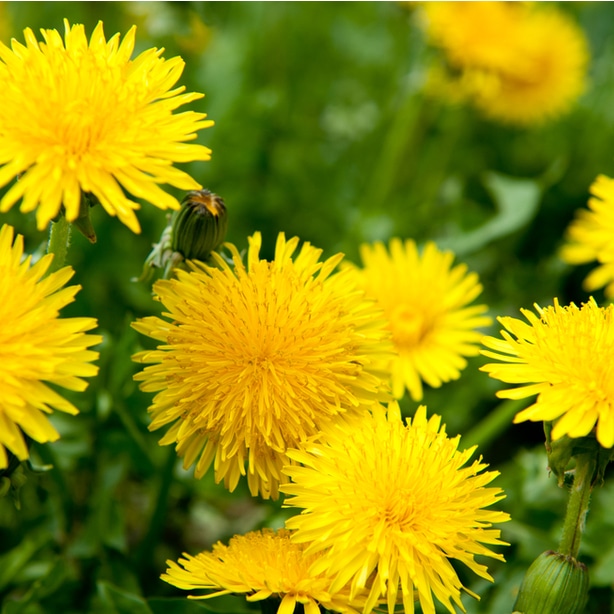
Weed Identification
The dark green leaves of these broadleaf perennial weeds are deeply toothed and jagged. The leaves of the dandelion plant are low growing and form a rosette near the earth. The leaves are sturdy and will remain dark green throughout the entire year.
The vertically growing taproot is resilient, and even small pieces left alive in the soil after removal results in the dandelion plant’s regeneration.
The yellow flowers comprise a collection of individual florets. A yellow flower forms at the center of the rosette and is lifted upward by a hollow stem. As the weed seeds prepare to ripen, the flower heads will close up and the hollow stem will fall back towards the ground. Once the weed seeds have ripened, the stem will rise upward again, this time with a ball of dandelion seeds that have what are essentially wind sails attached to them. These “sails” support the dispersal of the seed on the wind.
Dandelions are most commonly found growing in lawns amongst the grass but can be found in gardens and flower beds if the conditions are appropriate.
Problems Caused
Every part of the dandelion plant releases ethylene gas that has an allelopathic effect on surrounding plants and inhibits their growth.
The virile growth of dandelions might out-compete the growth of your desirable grasses and plants. The seed head that rests upon the stalk is easily dispersed over great distances. If your turf is weakened or compromised, once the dandelion establishes its taproot, they become challenging to remove. It is nearly a guarantee that new plants will form if any portion of the taproot remains alive in the earth.
Weed Control Methods
There are several selective and non-selective chemical applications, along with several organic alternatives. You can also use a weed burner specifically designed to control dandelions.
Because dandelion plants are difficult to control, the best way to deal with them is to make sure that they don’t show up in the first place. Preventative maintenance with proper lawn care practices is usually the best remedy for any potential lawn problem.
Using both pre and post-emergent herbicides and making sure that any of the taproot left behind in the soil is killed is a good recipe for dandelion control.
Creeping Buttercup
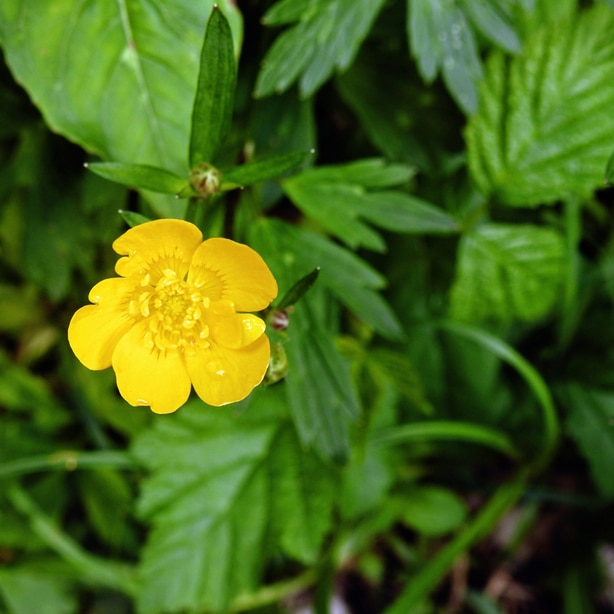
Weed Identification
This perennial weed has leaves that consist of three leaflets that are lobed and turn light green in color as the plant matures. The center leaflet of the creeping buttercup has a long stalk. The leaves grow prostrate and spread along the ground as far as 5 square yards per year.
The bright yellow flowers of these perennial weeds have 5 petals that appear shiny in direct sunlight. The flowers bloom from May to August and rest upon a grooved stalk that can grow as tall as 1 foot.
Problems Caused
In lawns and gardens, the perennial weed is a problem because its low growth habit makes it resistant to mowing and the leaves are resilient to traffic.
A toxin in the plant can cause gastrointestinal discomfort if consumed by your pets. The creeping buttercup is thought to be harmful to the plants surrounding it because it depletes potassium in the soil, affecting its availability to surrounding grass and ornamental plants.
Weed Control Methods
Removing the creeping buttercup at its growing point at the soil level should be sufficient to prevent regeneration. Cut the stalks at an angle under the rosette formed by the leaves and removal should be relatively easy.
The weeds prefer moist soil. Ensuring that your lawn drains appropriately and that the soil is not compact will go a long way at preventing these weeds.
Because the viability of the seeds in the ground is so long, chemical treatment will most likely take several applications to eliminate them from your lawns and gardens. This is best accomplished using a weed and feed product to ensure that the other desirable plants and grass are receiving an adequate infusion of nutrients as you combat the creeping buttercup.
The seeds have been shown to remain viable for up to 80 years, so the likelihood of encountering new plants after the first application of your weed and feed product or preferred herbicide is very high.
Purslane

Weed Identification
Purslane is a summer annual weed that grows as tall as 6 inches with a breadth of up to 2 feet. Purslane is a succulent with stems that are thick and round at the base of the plant. The succulent weed is very tolerant of drought and heat and only grows in the hottest months of the year.
The leaves of the purslane plant are broad and rounded at the tip and narrow at the base. Both the stems and leaves often have a reddish tint to them. The leaves of the purslane alternate and are often clustered at the end of its branches.
The purslane blooms pale yellow flowers that consist of four to six broad round petals. The flowers are sessile and not raised upon a stalk. These yellow flowers are solitary and arranged in the leaf axils. You will often find several individual flowers close together within the leaf clusters at the end of its branches.
It should be noted that some of the flowers can be pink instead of yellow.
Problems Caused
This summer annual plant can be difficult to control because of its various survival methods. Even after you think you have rid yourself of your purslane problems, new shoots will somehow defy the odds and emerge out of your turf.
Because of its survival mechanisms and its ability to disperse seed far from their source, purslane can outgrow desired species completely and overtake areas of your lawns and gardens.
Weed Control Methods
Gardeners should deal with this annual weed while it is young. Once it has spread its seed, it can become challenging to control. This weed is best controlled by pulling it from the earth. An herbicidal application may not be necessary.
Because of the seed’s ability to ripen after the mother plant has been pulled from the ground, the key to dealing with this annual weed plant is in how you dispose of it. Do not mix them into your compost pile because they can ripen and germinate in that environment. Place the plants that you pull from the soil into a bag and close the top of it when you are finished.
Ensure that when you pull this weed from the ground that you do not leave any living piece of its root system in the soil because it can regenerate.
Weeds With Pink Flowers
Red Clover
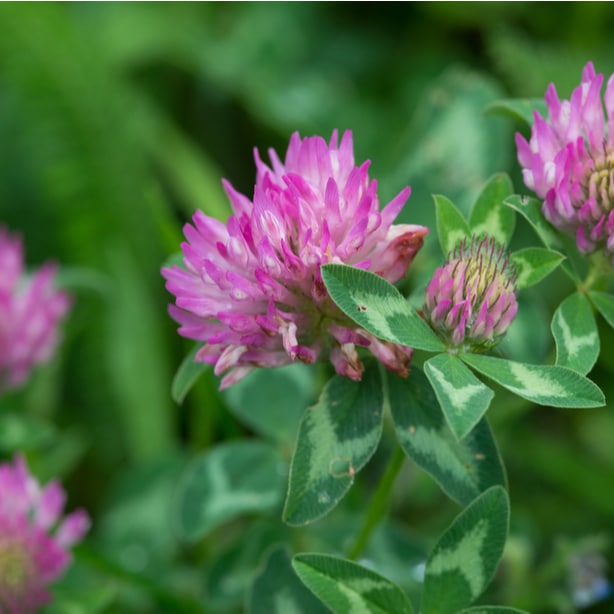
Weed Identification
Red clover is a perennial weed of the same family as the white clover you read about earlier. The two are nearly identical plants, but red clover has slightly longer leaves than white clover and has a more rounded edge.
The dark pink flowers appear in dense clusters of tightly packed florets. Again, the flower is nearly identical to that of white clover, except these flowers are pink. The pink flowers of this perennial appear from May to September.
Problems Caused
This low growing perennial is not as aggressive as its cousin. Red clover is found in lawns with depleted nitrogen. This can occur in compact soil or excessively moist soil that has experienced nutrient runoff.
Its appearance is likely a sign of larger problems in the overall health of your lawn.
Weed Control Methods
Because it is not as aggressive as white clover, red clover can easily be pulled from the soil. You will need to remove it from the main growing point. Red clover has a fine root system that will not regenerate once the plant has been pulled from the earth.
A selective product, both pre and post-emergent, can effectively kill this perennial weed without damaging your desired grasses that surround it.
Selfheal

Weed Identification
This perennial broadleaf weed is a member of the mint family and can be found in lawns and gardens with a wide variety of growing conditions. The selfheal has leaves that are oval with slightly scalloped edges. The surface of the leaves of this perennial weed can range from smooth to slightly hairy.
The flowers of this perennial weed can range from pink to purple and can be found from May through September. The flowers appear at the end of the terminal spikes of the plant’s stem. The flowers will appear in vertical layers growing out from the terminal spike of the stem.
Problems Caused
Because selfheal is low-growing, it can survive when you lower the blade of your lawn mower. As it spreads, it can restrict and prohibit the growth of your desired grass and plants. Left unchecked, this perennial weed will spread its root system far enough that you will have to completely remove sections of your lawn and re-seed or sod that area with new turfgrass.
Weed Control Methods
If you notice a small number of these weeds growing on your lawn, you should be able to remove them by hand and be done with it.
The best practice for dealing with selfheal is, as always, proper lawn care practices and preventative maintenance. Effective and proper lawn mowing practices should suffice to prevent these perennial weeds from developing seeds.
If your infestation has grown to more than just a few of these weeds, a selective post-emergent herbicide should work well. One application of an herbicide should be enough to wipe out these weeds, but cover all your bases and give the area another dose of the selective product after a month.
Spear Thistle
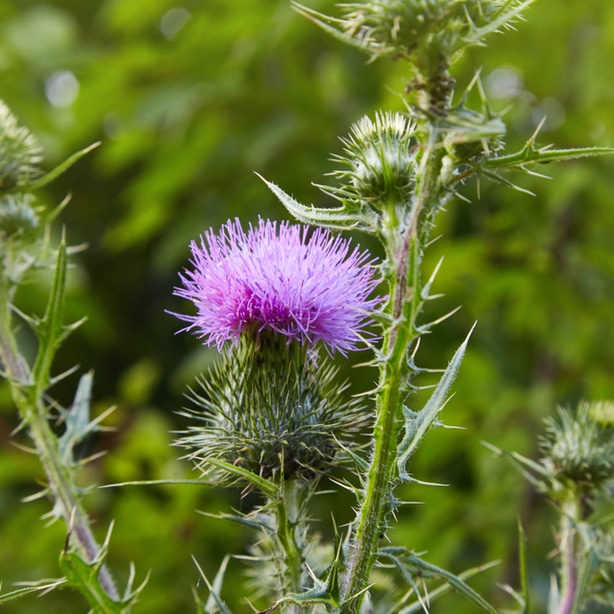
Weed Identification
Spear thistle is a biennial weed that can grow taller than 3′ in its second year of life. The dark green leaves have spines that cover the edges and the surfaced. The leaves of these biennial weeds are lighter on the bottom because of the dense growth of fine hairs. They are deeply lobed with a long spine at the top of each lobe. In its first year of growth, the spear thistle grows outwardly along the ground and shoots up vertically in its second year.
The new vertically growing shoots produce many compound pink or purple flowers. The flowers comprise tufts of pink petals growing from spheres of spined bracts.
Problems Caused
If your uncovered skin comes into contact with the spines of this biennial weed, you’ll experience some localized pain at the contact site.
The spear thistle will colonize primarily in undisturbed and uncultivated areas like pastures and roadsides. This can prove to be a problem for those of you with hayfields. These weeds also have a bitter taste that keeps grazing animals from controlling their growth through foraging.
The large size and rapid growth of these weeds will out-compete the growth of desirable plants. If allowed to grow into their second year, the spear thistle can wind up shading desirable plants throughout the growing season and inhibit their growth.
Weed Control Methods
Spear thistle reproduces only through seeding, so it’s important to get to them before fresh seeding occurs. In gardens, spear thistle is destroyed by surface cultivations in the spring and by hoeing or tilling the ground as necessary. Young plants should be removed at the rosette stage in the first year of growth.
Spear thistle weeds can be pulled from the ground when in bloom or cut below the rosette at the taproot in the first year of growth. Manual pulling is best done in moist soil in the spring and fall.
A non-selective herbicide can be used to kill these weeds. Because of their voracious growth, it’s best to treat them with the chemical before the flowers have bloomed and the seeds are beginning to spread.
Weeds With Purple or Blue Flowers
Creeping Charlie (Ground Ivy)

Weed Identification
Creeping Charlie (ground ivy) is a perennial weed that spreads by seed and grows along the ground. Creeping charlie (ground ivy) produces round or heart-shaped leaves that are bright green and have scalloped edges. The leaves grow opposite one another on the square, creeping stems that take root at the nodes.
The purple or bluish flowers bloom in the spring months. The flowers are funnel-shaped and tend to open towards the ground because of their weight at the end of the stem.
Problems Caused
The primary issue caused by creeping charlie (ground ivy) is that its growth will out complete desired plants and eventually smother them. Creeping charlie (ground ivy) thrives in moist soil and shaded areas, so your desired plants in these spots are already at a disadvantage.
Weed Control Methods
If your lawn has areas that are prime for creeping charlie to overtake, then you need to amend them as soon as possible. You can do this by opening up the area so that it receives more sunlight and improving the drainage of the soil.
Proper mowing techniques are another good defense at keeping this perennial weed off of your lawn. Once these weeds are fully established, they are extremely difficult to remove completely by hand.
If creeping charlie (ground ivy) has already established itself, you can use a selective post-emergent herbicide to quell the invasion, but preventing these lawn weeds from showing up in the first place is the best course of action.
Wild Violet
Weed Identification
Wild violet is a bit of a misnomer. It’s a collection of different wildflowers that have a few specific features in common. The truth of the matter is that they are altogether different plants. To add more confusion to the identification of this plant, it is also related to both pansies and violas. They have some structural components that are very similar.
Some folks cultivate wild violet as a desired ornamental in their lawns and gardens. Others see wild violet as nothing more than an aggressively growing broadleaf perennial weed plant that needs to be eradicated.
Wild violets have heart-shaped leaves with rounded teeth on their edges and come to a point at the peak.
Wild violets spread through seed and through short rhizomes that can be found at the base of the plant. The rhizomes can be found at the base of the plant and are native to every different species of wild violet. You can find this perennial weed in various growing conditions ranging from sunny, drought-like conditions to shaded areas where the soil is full of moisture.
The flowers of the wild violet vary depending on the species that you encounter. The colors range from dark blue, to the spectrum of purple shades, to yellow, all the way to white. What each species flower has in common is that it consists of 5 petals and sepals that are bilaterally or radially symmetrical. Sometimes, a separate, lower petal is larger and projects backward like a boot spur. Here are some pictures of the more common wild violet flowers:
Confederate Violet

Yellow Violet
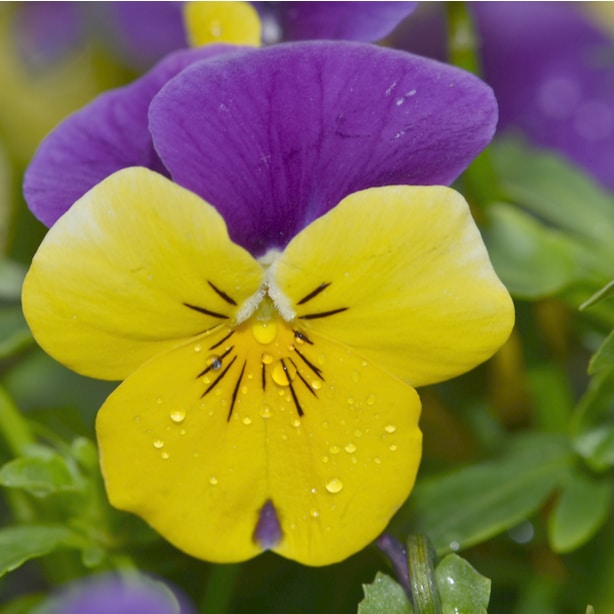
Common Blue Violet
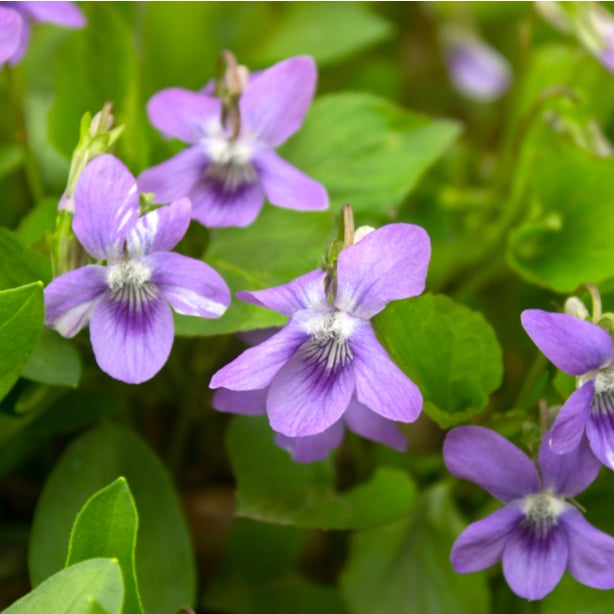
Freckles Violet
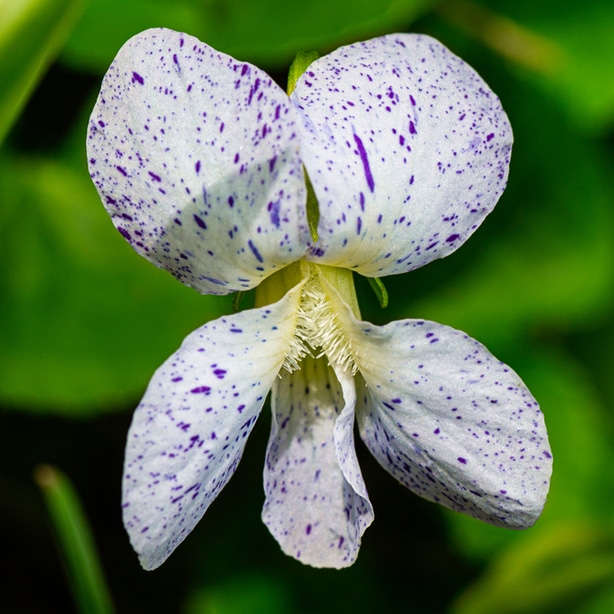
Problems Caused
Although closely related to violas and pansies, both desirable ornamentals commonly found in lawns and gardens, wild violets are wildflowers that can outgrow your desirable plants and steal nutrients from them.
The major problem associated with the presence of wild violets around your lawn and garden is that it is hard to control their growth. In a fairly short time, these perennials can inundate your garden.
Weed Control Methods
Wild violets can be controlled by pulling them from the ground. However, the rate at which these perennial lawn weeds spread means that this method is best employed on smaller patches. For larger areas of growth, spot treat these lawn weeds in areas where they are growing.
Spot treatment ensures that you aren’t introducing more chemicals to the environment than what is necessary. The best time to spray your herbicide is in the fall, as wild violet is transporting sugars from its leaves down to its taproot for the winter. This timing ensures that your herbicide uses the natural processes of these lawn weeds to transport the herbicide to the taproot to kill it completely.
Some organic alternatives include the use of vinegar or a solution made with dish soap that you can spray onto these lawn weeds.
Tall Flowering Weeds
Now that you know about the more common flowering weeds that grow closer to the earth, let’s examine some common flowering lawn weeds that grow a bit taller than the rest.
Garlic Mustard
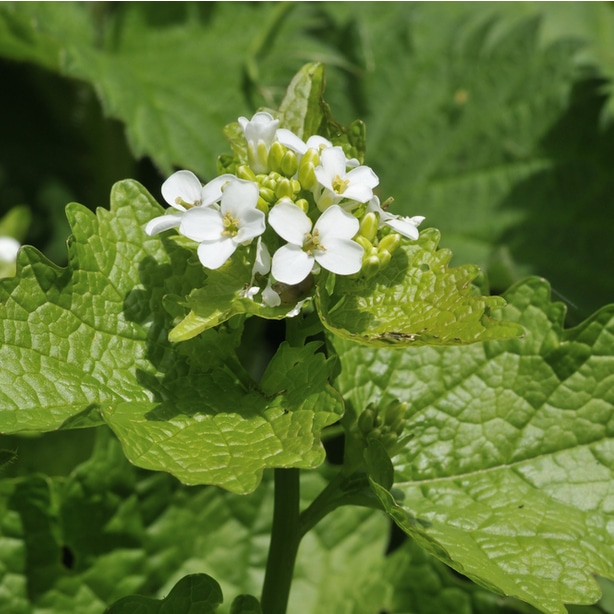
Weed Identification
Garlic mustard is a biennial weed found in damp, shaded areas of your lawn. This is especially true of lawns that run up against a wood line. The heart-shaped leaves are toothed and have long stems. The taproot, which smells of horseradish, develops in the first year of growth with a basal rosette of leaves that will remain through winter. In the second year, the stem can grow to be 40″ tall.
In the spring and summer of the second year of growth, small white flowers with 4 petals will appear in clusters that open in succession. These flowers are self-pollinated. A thin, four-sided pod that holds the shiny, black seeds will burst open to disburse the seeds of the weed.
Problems Caused
This weed was introduced to North America in the mid-nineteenth century as a culinary herb. The leaves of this weed combine the flavors of mustard and garlic into one bite.
However, now it is considered a problem plant because of its noxious odor and because of its seed dispersal is so great in such a small area. Once the seeds have fallen to the soil, the weed will wind up outgrowing the native undergrowth in that area. The taproot also releases an allelopathic chemical that inhibits the growth of beneficial fungi.
Weed Control Methods
Garlic mustard is pulled from the ground easily, but you must ensure that you kill any pieces of the taproot that remain in the soil after extracting the plant. Cutting the weed back repeatedly will eventually prevent the flowering shoot from developing seeds.
A pre-emergent herbicide along pathways and wood lines should prevent garlic mustard germination.
Japanese Knotweed

Weed Identification
Japanese knotweed is a perennial weed that can grow as tall as 15 feet. The thick, fibrous stalk has led to this weed being called Japanese bamboo.
The Japanese knotweed will form large, broad leaves that are rounded at the base and taper towards the end. They grow from 3 to 6 inches long and from 2 to 4 inches wide. The leaves can vary in shape depending on the age and establishment of the plant. The shape can range from broadly oval to somewhat triangular or heart-shaped.
Japanese knotweed has small white flowers that bloom from late summer to early fall. The flowers appear in spikes or loose clusters called panicles.
These lawn weeds are often cultivated and purposefully grown for the natural privacy their thick, tall foliage provides. Still, this perennial, herbaceous plant is considered to be invasive.
Problems Caused
The root system and hearty growth of Japanese knotweed can damage your home’s concrete foundations, driveways, walkways, and retaining walls.
Its thick growth habit will crowd out any desired vegetation and, in the eastern United States, it is considered one of the worst invasive exotic plant species. Its roots can grow up to 10 feet deep and over 20 feet wide. These dimensions, along with its resiliency in the face of cutting it back, make this invasive perennial weed very difficult to remove from your lawn or garden completely.
Weed Control Methods
To eradicate Japanese knotweed from your lawn or garden, you’ll have to kill its extensive root system completely. You can weaken the Japanese knotweed roots by cutting back all above-ground growth, but this alone will not kill them.
You can reduce the amount of Japanese boxwood by applying glyphosate, imazapyr, or a combination of both. But you must ensure that every last piece of the roots is dead or the plant will undoubtedly reemerge in the future.
Some people have ventured so far as to attempt to dig up the entire system of the Japanese knotweed’s roots. This can be very labor-intensive and, if you leave anything behind, potentially an exercise in futility. The nature and rate of the growth of this weed ensure that it will return.
Given the virile and aggressive nature of this plant, your best bet is to control any invasion before it starts. Get rid of these weeds while they’re young and their roots aren’t fully established. Proper preventative maintenance and lawn care practices, along with a certain degree of vigilance, are your best bet.
Canada Thistle
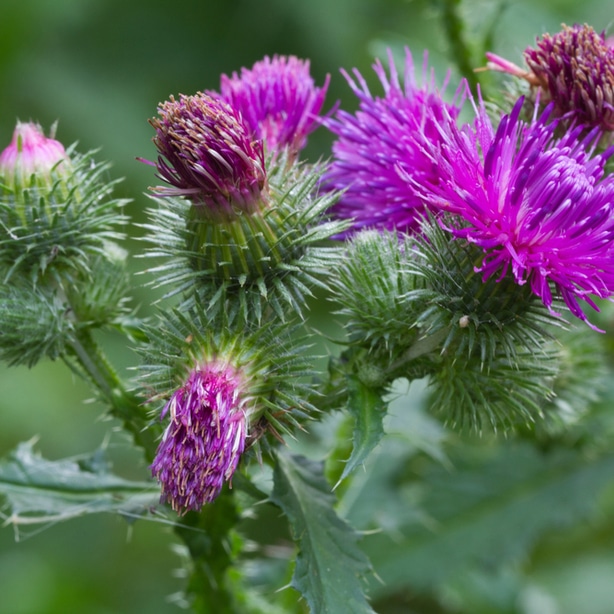
Weed Identification
Canada thistle, also known as creeping thistle or field thistle, is a perennial flowering plant that can grow up to 5 feet tall. They thrive in areas with moderate temperatures and where groundwater is plentiful.
The leaves of this perennial flowering weed are wavy and lobed. The edges of the leaves are covered with sharp yellow spines as a defense mechanism against foraging and grazing animals. You’ll also find a pronounced spine at the tip of each leaf.
The leaves shoot from the stalk that grows vertically from the soil and can be up to 6 inches long. The stalk does not have spines.
From late summer to early fall, Canada thistle produces pink or light purple flowers. The pink flowers are round and appear in clusters at the end of each branching stem. The heads of the flowers are about ¾ of an inch wide.
If the flowers are afforded the chance to go to seed, they will lose their color and become white and fluffy, much like the dandelion.
Problems Caused
Canada thistle has a reputation for being impossible to get rid of in your lawn or garden. These perennial weeds’ taproots can grow more than 10 feet deep with horizontal roots branching off of it that can spread more than 20 feet.
The vigorous growth of these weeds can overtake the desired vegetation in your lawn or garden. Also, the height of these weeds can wind up depriving lower growing plants of sunlight, which will inhibit photosynthesis.
Not to mention the spines on these perennials are painful against the skin.
Weed Control Methods
The best way to control Canada thistle is by making your lawn less hospitable for it to take root. While it can grow almost anywhere, it’s partial to soils with low fertility and open areas. So, perform a soil test and ensure that the nutrient makeup of your lawn is up to par. If it’s not, make corrections through fertilizing and with soil amendments like compost. This will encourage the growth of desired vegetation, which, in turn, will discourage Canada thistle.
You can use herbicide on Canada thistle, but it will likely take several applications to kill its extensive taproot and branching roots completely.
Organically, you can cut the visible vegetation off at the soil level. Do not attempt to pull the taproot from the soil as it could split. Instead, periodically return to the Canada thistle and cut off any new growth.
The idea is that the weed will deplete all of its energy reserves growing new vegetation while not allowing those reserves to be built back up. This will eventually kill the enormous taproot.
Velvetleaf
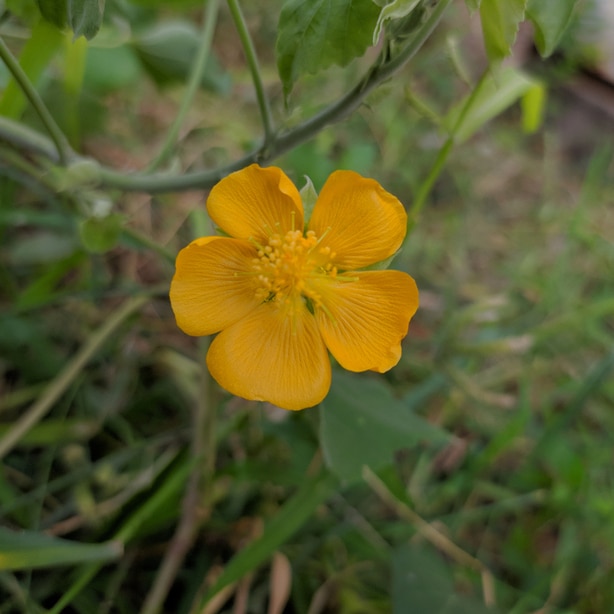
Weed Identification
The velvetleaf is an annual summer plant that can grow up to 8 feet tall on stout stems that are covered in soft, velvety hairs. The plant will form large heart-shaped leaves that grow at different points on the stem. Each leaf has long, stout stalks that support its weight. When the leaves of the velvetleaf are crushed, they emit a very distinct smell.
The velvetleaf produces yellow flowers that can grow to be 1 inch in diameter. The yellow flowers, which grow on stalks, have five petals that are fused together at their base. The flowers can be found singly or in clusters where the leaf stalk meets the stem.
This summer annual produces seed pods that consist of 12 to 15 woody segments that stay joined as the seed mature. Once the seeds are mature, the pod releases the seeds through vertical slits on its outer surface.
Problems Caused
The velvetleaf is a competitive weed for vegetables in your garden. It sucks water and nutrients from the soil, which can compromise the healthy, sustained growth of your plants. This summer annual also contains a chemical that inhibits the germination and growth of your plants. With the germination and growth of your desired vegetation stymied, velvetleaf is then able to establish a dense monoculture in that area.
Weed Control Methods
Herbicides work well for controlling the velvetleaf plants in your lawn or garden. However, it’s recommended that you use a pre-emergent herbicide to prevent it from showing up in the first place. The adaptations this plant has made to increase its chance of survival are harmful to your other plants, and having just one velvetleaf around your healthy plants is too many.
A quick response to the appearance of velvetleaf is crucial if you’re trying to prevent an invasion. Mow areas with the weed while it is still small and you will prevent it from seeding and replicating. Once the plant goes to seed, it becomes exceedingly difficult to curtail.
Sunflower

Weed Identification
Lo and behold, the plant that is so beautiful and produces a treat that is consumed by the bucket at baseball games is actually a weed. Sorry to be the bearer of bad news.
Sunflowers are annual weeds that can grow as tall as 15 feet. The widely cultivated plant has leaves that are broad and coarsely toothed. The rough leaves are arranged in spirals and grow from 3 to 12 inches long. The alternate leaves are heart or egg-shaped and, along with the stems, have coarse hairs.
The heads of the sunflowers consist of yellow, pleated petals and a maroon center that can appear to be blacks. The heads are daisy-like and consist of 20 to 40 yellow florets. As the seeds ripen, the center begins to appear more black than maroon. Although you’re probably familiar with the single flower, a single sunflower plant can produce multiple flowers that branch out from a single stalk.
Problems Caused
Setting aside the delicious seeds that the sunflower produces, there are a couple of problems that sunflowers can cause around your lawn or garden.
The primary issue with having this weed around your garden is that they are allelopathic. This, again, means that they secrete a chemical that inhibits the growth and germination of the plants that surround them. While they are beautiful and provide you with a treat in their seeds, having them too close to desired vegetation in your garden can impede the healthy growth of your other desirable vegetation.
Weed Control Methods
Strategically placed, sunflowers can be advantageous to your garden by inhibiting the growth of weeds in your garden. In fact, it can make a good companion plant to certain vegetables like cucumbers.
But if one just shows up on your lawn without your permission, then it needs to be dealt with. There are a few easy steps you can take to rid yourself of this beautiful annual plant. Follow these steps:
- If the sunflower has seed heads or is in bloom, place a tarp on the ground beneath it. Then cut off the blooms or seed heads and place them in a trash bag.
- Cut the stalk and other foliage to the ground.
- Dig out the roots with a spade. Be prepared, established roots can be widespread and take time to remove.
- Pull up any new shoots as soon as you see them.
If you don’t have the time or inclination for the natural route, you can always break out the herbicide to deal with your sunflower invasion.
We are hopeful that this identification and troubleshooting guide will help you make your lawn and garden more beautiful!

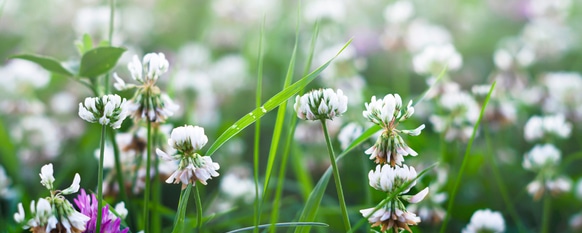
Thank you for publishing this useful weed guide! I have a landscaping company. I like the idea of having a large picture of the weed, sorted by colors, then having a common reason for the weed to be growing in that area is very helpful. We know how to spray them with a chemical, but why are they there and how do we correct that problem? You just answered those important questions! Thank you again!!
Any idea if this is a weed
I don’t see anything in particular you’re referring to. Do you have particular invasive plant in mind? Or have a picture?
Sorry it should have added…it looks like it’s in now. I have heard wild Phlox but I haven’t been able to see a picture of the leaves, only the flower. The leaves are not what I associate with wild Phlox.
Trying to identify this weed
Closeup shot
I love alot of the native “weeds” here! sunflowers, violets, buttercups, clover. i don’t have “lawn” grass- no mowing needed.. just clover, baby’s breath and other native Pa plants…also beebalm and other plants that butterflies and humming birds love!
Lots of garden critters are
welcome in my yard🌸
I’m having trouble identifying this weed
I fell on this weed a week or so ago. The spines punctured my skin. It seems to be healing but the area is very sore. Can anyone tell me what kind of weed it is and whether or not it injects toxins into its victims?
A lot of those have medicinal and edible uses! Get to know your weeds before you eliminate them.
Absolutely! And dandelion actually brings nutrients to your plants in the garden amd has them grow. Plus they are DELICIOUS! I just made dandelion jelly the other day. You can’t get much better than that! Like you say, learn your food and your medicine in your yard and stop killing it. People didn’t come thousands of years with CVS around every corner